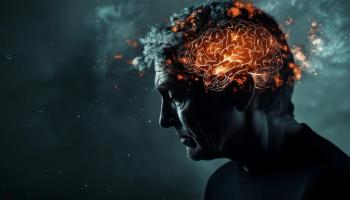
What’s in a Word? Taking the Measure of Thoughts in Schizophrenia
Artificial intelligence and natural language processing provide powerful new tools to measure thought disorder and negative symptoms in schizophrenia.
Words. Phrases. Dialogues. The breaths in between. The cadence, tonality, and dynamics of the voice. These are so often the tangible substrate of our work as psychiatrists, whether we are an analyst in an armchair, dissecting and reconstructing a patient’s narrative, or a biological psychiatrist with pen in hand, translating the patient’s report into scales and delving for correlates in the brain. Although powerful and incisive, the most advanced methods of biological psychiatry—from neuroimaging and magnetoencephalography to induced pluripotent stem cells—are still far from overthrowing the primacy of patient reports. Syllable and sound are still the primary means for taking the measure of thoughts and emotions.
One of my most memorable patients was a graduate student studying computer science. When I prompted her about her symptoms or medication adverse effects, I received staccato, unelaborated responses. But when I brought up programming, I found myself listening in fascinated confusion for minutes on end as she spoke about computer architecture, machine learning, and her views on cybersecurity—jumping from idea to idea and sometimes seeming to talk about multiple subjects at once. I frequently struggled to follow her thoughts, which were equal parts brilliant and bewildering. What if there were a way to turn this waterfall of words—which I could barely understand—into useful data?
Speaking of Schizophrenia
In schizophrenia, speech and language disturbance have been recognized as core components of the disorder since the fledgling days of modern psychiatry. In his canonical description of dementia praecox, which is often credited as the first modern characterization of schizophrenia, Emil Kraepelin, MD, described both positive (eg, incoherence, derailment, stereotypy, neologisms) and negative symptoms (eg, mutism) associated with speech (
Moreover, it was observed that speech abnormalities in schizophrenia were not limited to content, but extended to prosody and vocal qualities: “The cadence often lacks the risings and fallings, the melodies of speech.”1 Kraepelin and others extrapolated these speech and language disturbances to indicate not only an impairment in communication, but also fundamentally disordered thought—at times derailment or loosening of associations, at times a poverty of thought.1,2
Nancy Andreasen, MD, PhD, was among the first to formalize the assessment and measurement of thought disorder with her 1986
Artificial Intelligence and the Measurement of Speech
Through advancements of machine learning and artificial intelligence, our modern digital era offers new tools for taking the measure of speech and thought disturbance. Methods for extracting information from human speech can be roughly divided into 2 areas. First, acoustics analysis extracts and quantifies information on pitch, amplitude, and vocal qualities on a millisecond-by-millisecond scale. Second,
Corcoran and colleagues later used latent semantic analysis to show that reduced coherence (ie, greater leaps in content)
Recently, my colleagues and I
In another study, we combined acoustic and lexical speech features in machine learning models to predict separate items from the TLC.12 Importantly, we noted that speech disturbance in schizophrenia is likely multifaceted, and it should not be treated as a single uniform entity.
The Future of Speech Biomarkers
Based on their ability to measure thoughts in an automated, fast, objective, and inexpensive manner, speech biomarkers could fundamentally alter clinical psychiatric practice. As illustrated in
Imagine a patient walking into an intake appointment and describing their experiences and their circumstances. The psychiatrist hands the patient a tablet, which leads them through some brief speaking tasks. A spinning wheel appears for a few seconds, followed by numbers and graphs that reflect their symptoms and their related brain circuitry correlates. This information brings up a menu that includes recommended digital therapeutics, pharmacology, and psychotherapy, and offers ways to track progress and to warn of relapses before they occur. The scenario would not be very different from checking cancer markers in oncology, autoantibodies in rheumatology, or myriad existing paradigms in other medical fields.
Already, early evidence suggests that speech biomarkers reflect underlying changes in the brain. In work by
Concluding Thoughts
As we stride into this new frontier, it is important to remember that our mission is the healing and well-being of individuals and families. This is not science for the sake of curiosity, no matter how intriguing the findings. This is not technology for the sake of novelty, no matter how nifty the gadget. Finally, the availability of brain measures should not mandate reliance on pharmacology over psychosocial interventions—quite the opposite. Automated language processing can be harnessed to measure changes in thought and brain structure on a personalized level. This layer of technology should not occlude the individual but rather allow clinicians to delve deeper into each unique case.
Dr Tang is an assistant professor of psychiatry at the Feinstein Institutes for Medical Research and the Donald and Barbara Zucker School of Medicine at Hofstra/Northwell. She is the cofounder and chief science officer of North Shore Therapeutics. Disclosures: Dr Tang serves as a consultant for Winterlight Labs.
References
1. Kraepelin E. Dementia Praecox and Paraphrenia. Livingstone; 1919.
2. Vygotsky L. Thought in schizophrenia. Arch Neurol Psychiatry. 1934;31;1062-1077.
3. Andreasen NC.
4. Cho S, Nevler N, Shellikeri S, et al.
5. Corcoran CM, Mittal VA, Bearden CE, et al.
6. Elvevåg B, Foltz PW, Weinberger DR, Goldberg TE.
7. Corcoran CM, Carrillo F, Fernández-Slezak D, et al.
8. Rezaii N, Walker E, Wolff P.
9. Mota NB, Vasconcelos NA, Lemos N, et al.
10. Birnbaum ML, Ernala SK, Rizvi AF, et al.
11. Tang SX, Kriz R, Cho S, et al.
12. Krell R, Tang W, Hänsel K, et al. Lexical and acousting correlates of clinical speech disturbance in schizophrenia. Workshop 35th AAAI Conf Intell. 2021:9.
13. Palaniyappan L, Bezerra Mota N, Oowise S, et al.
Newsletter
Receive trusted psychiatric news, expert analysis, and clinical insights — subscribe today to support your practice and your patients.














